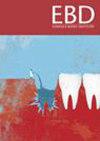Unmasking the hidden risks: clinical implications of 4 premolar extraction orthodontics on health and upper airway dynamics
Q3 Dentistry
引用次数: 0
Abstract
Zhang J, Chen G, Li W, Xu T, Gao X Upper airway changes after orthodontic extraction treatment in adults: a preliminary study using cone beam computed tomography. PLoS ONE 2015; https://doi.org/10.1371/journal.pone.0143233 . Retrospective study and untreated matched controls. PubMed, journals.plos.org, researchgate.net, Google Scholar. This retrospective study enrolled 18 adults with Class II and hyperdivergent skeletal malocclusion (5 males and 13 females, 24.1 ± 3.8 years of age, BMI 20.33 ± 1.77 kg/m2). And 18 untreated controls were matched 1:1 with the treated patients for age, sex, BMI, and skeletal pattern. Age >18 years; sagittal Class II (ANB > 4.7°) and vertical hyperdivergent (MP/SN > 37.7°) skeletal pattern; convex profile evaluated by E line; no missing teeth except for the third molars; orthodontic camouflage treatment with extraction of four premolars and maximum anchorage using mini-screws; and available CBCT data both before and after treatment. Body mass index (BMI) > 25 kg/m2. Rapid maxillary expansion, protraction facemask therapy, extra-oral force to push molars distally, functional appliances, and orthognathic surgery. History of cleft lip or palate. Hyperplasia of tonsils or adenoids or history of tonsillectomy/adenoidectomy. Snoring or other sleep disorders. Four premolar extraction, upper incisors retracted 7.87 mm, lower incisors retracted 6.10 mm. The cross-sectional area of the upper airway was not changed, but the sagittal dimension between the soft palate and the posterior pharyngeal wall were significantly decreased. The study reported that its null hypothesis was not rejected, with no significant difference in the airway size and significant compression of the sagittal posterior airway.揭开隐藏风险的面纱:4颗前臼齿拔除矫正对健康和上气道动力学的临床影响。
张健,陈刚,李伟,徐涛,高翔。成人正畸拔牙后上呼吸道变化的锥形束计算机断层扫描初步研究。PLoS ONE 2015;https://doi.org/10.1371/journal.pone.0143233 .设计:回顾性研究和未治疗的匹配对照。数据来源:PubMed, journals.plos.org, researchgate.net,谷歌Scholar。研究选择:本回顾性研究纳入了18例II类和高分化骨错颌合的成年人(男性5例,女性13例,年龄24.1±3.8岁,BMI 20.33±1.77 kg/m2)。18名未接受治疗的对照组与接受治疗的患者按年龄、性别、体重指数和骨骼模式进行1:1匹配。纳入标准:年龄bb0 ~ 18岁;矢状II类(ANB > 4.7°)和垂直超发散(MP/SN > 37.7°)骨骼模式;用E线求凸轮廓;除第三磨牙外没有缺牙;正畸伪装治疗:拔除4颗前磨牙并使用微型螺钉进行最大支抗以及治疗前后的CBCT数据。排除标准:体重指数(BMI)≥25 kg/m2。快速上颌扩张、牵引面罩治疗、口外力远端推动磨牙、功能矫治器和正颌手术。唇腭裂病史。扁桃体或腺样体增生或有扁桃体/腺样体切除史。打鼾或其他睡眠障碍。结果:前磨牙拔牙4颗,上门牙内缩7.87 mm,下门牙内缩6.10 mm。上呼吸道的横截面积没有改变,但软腭与咽后壁之间的矢状面尺寸明显减小。研究结论:本研究报告其原假设未被否定,气道大小无显著差异,矢状后气道受压明显。
本文章由计算机程序翻译,如有差异,请以英文原文为准。
求助全文
约1分钟内获得全文
求助全文
来源期刊

Evidence-based dentistry
Dentistry-Dentistry (all)
CiteScore
2.50
自引率
0.00%
发文量
77
期刊介绍:
Evidence-Based Dentistry delivers the best available evidence on the latest developments in oral health. We evaluate the evidence and provide guidance concerning the value of the author''s conclusions. We keep dentistry up to date with new approaches, exploring a wide range of the latest developments through an accessible expert commentary. Original papers and relevant publications are condensed into digestible summaries, drawing attention to the current methods and findings. We are a central resource for the most cutting edge and relevant issues concerning the evidence-based approach in dentistry today. Evidence-Based Dentistry is published by Springer Nature on behalf of the British Dental Association.
 求助内容:
求助内容: 应助结果提醒方式:
应助结果提醒方式:


